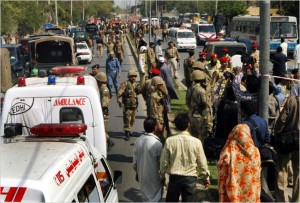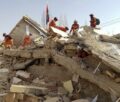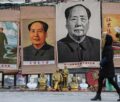Wave of terror hits Lahore

By Tushar Ranjan Mohanty
At least 57 persons, including eight Security Force (SF) personnel, were killed and more than 90 were injured as twin suicide blasts, moments apart from each other, ripped through the heart and cultural city of Pakistan, Lahore’s R. A. Bazaar in the cantonment area on March 12. The bombers struck during Friday prayers at around 12:50pm.
The first bomber targeted an Army patrol unit near a mosque. Gunshots were also heard following the attack. As rescuers rushed to help victims, another bomber struck some two minutes later, near the R. A. Bazaar bus stand, only a few yards from the site of the first attack.
According to Police sources, initial investigations suggest both the bombers, aged between 17 and 20 years, were on foot. The duo used suicide vests, weighing 10 kilograms each, packed with ball bearings and blades. Meanwhile, the Tehreek-e-Taliban Pakistan (TTP) and al Qaeda-linked Sunni terrorist organisation Lashkar-e-Jhangvi (LeJ) claimed responsibility for the bombings.
Later the same night, seven low-intensity explosions, six in Allama Iqbal Town Police Station area and one in the Samanabad area of Lahore, injured five persons. Intelligence sources have warned that four bombers were still present in the city, awaiting instructions to hit their targets.
Notably, the attacks happened despite heightened security following intelligence warning that an explosive-laden white car, with registration number 1320-A, had entered Lahore from Rawalpindi earlier in the day.
On March 8, a suicide bomber detonated his explosives-laden vehicle in front of the Special Intelligence Agency’s (SIA) office in the Model Town area of Lahore, killing 15 persons, including eight Security Force (SF) personnel, a woman, and a five-year-old girl, and injuring more than 80 others. The powerful blast, which was carried out using an estimated 600 kilograms of explosives packed with ball bearings and blades, damaged houses in a 0.5-kilometre radius and destroyed more than 40 cars in the area. The SIA office in Model Town K-Block, a residential area, was being used as safe house for Intelligence officials and detained suspects.
The March 8 incident, again, occurred despite a Punjab Home Department Circular issued on March 4 to the Punjab Inspector General of Police (IGP), the Assistant IGP (operations), the Special Branch AIGP, the Lahore commissioner, the Lahore Capital City Police Officer (CCPO) and the Rawalpindi Regional Police Officer, which specifically warned of terrorist attacks on intelligence offices in Islamabad, Rawalpindi, Lahore and Peshawar. Claiming responsibility, TTP spokesman Azam Tariq declared, “The attack was to avenge [US] drone attacks and [Pakistani] military operations in the Tribal Areas. We have 2,800 to 3,000 more suicide bombers … We will target all Government places, buildings and offices.”
Two major attacks over a gap of three days underline the reality that Lahore is under siege by TTP network, allowing the extremists to strike at will. Growing terrorist violence in Punjab as a whole and Lahore in particular over the past years is a manifestation of the progressive loss of control of the Pakistani intelligence and security apparatus over its own monstrous creations. The Army and paramilitary forces have launched a succession of military offensives against the TTP in the North West Frontier Province (NWFP) and the Federally Administered Tribal Areas (FATA) regions over the past years. Under pressure in their areas of dominance, the TTP and its affiliates have opened new fronts – in the Punjab and in Karachi, accelerating a rapid and firm inward movement, from the NWFP and FATA, to mainland Pakistan.
The entire Punjab Province is now under TTP network operational radar. According to SATP data, 441 persons, including 293 civilians and 97 SF personnel, were killed in terrorism-related incidents in the province in 2009 alone. Apart from Lahore, the national capital Islamabad and the garrison town of Rawalpindi [both of them in Punjab], are facing the brunt of the TTP’s attacks.
The attacks on Lahore have a particular resonance in Pakistan. The city has long been the country’s cultural capital and, as the most populous and prosperous town in the Province, is also regarded as the heart of the country’s powerful ruling establishment. Traditionally, Lahore has been home to the country’s top bureaucrats and military leadership. Punjab returns 183 of the 342-member National Assembly and, as such, the Provincial Capital is considered the country’s political nerve-centre as well, though the seat of Government is Islamabad.
Lahore had generally remained free of militant violence in the years after 2001, when Pakistan reluctantly and selectively joined the US-led campaign against Islamist terrorists. While occasional incidents were witnessed over the preceding years, the city has seen a sharp escalation since 2008. Only eight incidents were recorded in 2007, with no reported fatalities. 2008 saw 77 fatalities in 22 incidents. In 2009, 103 people were killed in 27 incidents.
Terrorism-related Incidents & Fatalities in Lahore 2007-2010
| Year | Number of Incidents | Civilian Fatalities | SF Fatalities | Terrorist Fatalities | Total Fatalities |
| 2007 | 8 | 0 | 0 | 0 | 0 |
| 2008 | 22 | 55 | 17 | 5 | 77 |
| 2009 | 27 | 54 | 38 | 11 | 103 |
| 2010* | 6 | 63 | 9 | 3 | 75 |
In addition to the three major attacks (involving three or more than three fatalities) in 2010, the most significant of the major incidents in 2009:
December 7, 2009: Two bomb blasts killed at least 38 people, and injured more than 100 at the crowded Moon Market in the Allama Iqbal area of Lahore.
June 12, 2009: At least seven persons, including a prominent anti-Taliban cleric, were killed and seven were injured, when a suicide attacker detonated himself at the Jamia Naeemia madrassa (seminary) in the Garhi Shahu area of Lahore shortly after Friday prayers.
May 27, 2009: Suicide bombers detonated a vehicle loaded with 100 kilograms of explosives near the offices of the CCPO and the Inter-Services Intelligence (ISI) in Lahore, killing at least 27 persons and injuring 326, destroying the two-storey building of the Rescue 15 Police Service. A colonel of the ISI and 15 Police officials were among those killed.
March 30, 2009: Eight Police recruits and a civilian were killed when a group of 10 terrorists attacked the Police Training Centre in Manawan with guns and grenades. SFs regained control of the facility in an operation that lasted for more than eight hours. About 93 cadets and civilians were injured.
March 3, 2009: Sri Lankan cricketers narrowly escaped a terrorist attack when terrorists ambushed the bus carrying them to the Gaddafi Stadium for the third day’s play of the second Test between Sri Lanka and Pakistan. At least seven persons – six policemen escorting the Sri Lankans and the driver of another van in the convoy – were killed and 20 persons were wounded in the attack near the Liberty roundabout, 500 metres from the Stadium. Seven Sri Lankan players were among the injured.
Within the wider trend of escalating violence is the increasing incidence of suicide attacks. Lahore saw three suicide attacks in 2009, resulting in the death of 86 persons, including 67 civilians and 15 SF personnel. The first two and a half months of 2010 have already seen three suicide attacks, in which 72 persons have been killed.
Fatalities in Suicide Attacks in Lahore 2009-2010
| Year | Incidents | Killed | Injured |
| 2009 | 3 | 86 | 451 |
| 2010* | 3 | 72 | 170 |
*Data till March 14, 2010 (Source: South Asia Terrorism Portal)
A total of 680 militants were arrested from different parts of Punjab in 2009. Of these, 185 were arrested from Lahore. 26 of the terrorists arrested in Lahore were suicide bombers. On December 20, the Police arrested Khalilullah, the Punjab ‘chief’ of the TTP, and a 17-year-old would-be suicide bomber, Usman alias Shahbaz, from the Manawan locality of Lahore. Khalilullah, was said to be the right-hand man of the slain TTP chief, Baitullah Mehsud, and allegedly masterminded the twin suicide bombings at Moon Market at Iqbal Town in Lahore on December 7, 2009. During interrogation, he confessed that Usman was to attack the flag-lowering ceremony at the Wagah border on December 22. Khalil also disclosed that he controlled a team of 600 suicide bombers.
Pakistan, and increasingly its Punjabi heartland, is paying a price for the country’s duplicity on terrorism. The country’s leadership continues to actively support terrorist groups operating against India and Afghanistan, even as it seeks to suppress groupings operating within Pakistan. The dividing lines between these diverse groups have, however, become increasingly blurred. The terror is returning, increasingly, to devour its own creators. And yet, few lessons have been learned by the military masterminds behind the monstrous Islamist terrorism that Pakistan’s State agencies have unleashed across South Asia.
( * The author works with the Institute for Conflict Management, New Delhi)
-
Book Shelf
-
 Book Review
DESTINY OF A DYSFUNCTIONAL NUCLEAR STATE
Book Review
DESTINY OF A DYSFUNCTIONAL NUCLEAR STATE
- Book ReviewChina FO Presser Where is the fountainhead of jihad?
- Book ReviewNews Pak Syndrome bedevils Indo-Bangla ties
- Book Review Understanding Vedic Equality….: Book Review
- Book Review Buddhism Made Easy: Book Review
- Book ReviewNews Elegant Summary Of Krishnamurti’s teachings
- Book Review Review: Perspectives: The Timeless Way of Wisdom
- Book ReviewNews Rituals too a world of Rhythm
- Book Review Marx After Marxism
- Book Review John Updike’s Terrorist – a review
-
-
Recent Top Post
-
 NewsTop Story
What Would “Total Victory” Mean in Gaza?
NewsTop Story
What Would “Total Victory” Mean in Gaza?
-
 CommentariesTop Story
The Occupation of Territory in War
CommentariesTop Story
The Occupation of Territory in War
-
 CommentariesTop Story
Pakistan: Infighting in ruling elite intensifies following shock election result
CommentariesTop Story
Pakistan: Infighting in ruling elite intensifies following shock election result
-
 CommentariesTop Story
Proforma Polls in Pakistan Today
CommentariesTop Story
Proforma Polls in Pakistan Today
-
 CommentariesTop Story
Global South Dithering Away from BRI
CommentariesTop Story
Global South Dithering Away from BRI
-
 News
Meherabad beckons….
News
Meherabad beckons….
-
 CommentariesTop Story
Hong Kong court liquidates failed Chinese property giant
CommentariesTop Story
Hong Kong court liquidates failed Chinese property giant
-
 CommentariesTop Story
China’s stock market fall sounds alarm bells
CommentariesTop Story
China’s stock market fall sounds alarm bells
-
 Commentaries
Middle East: Opportunity for the US
Commentaries
Middle East: Opportunity for the US
-
 Commentaries
India – Maldives Relations Nosedive
Commentaries
India – Maldives Relations Nosedive
-
AdSense code




















